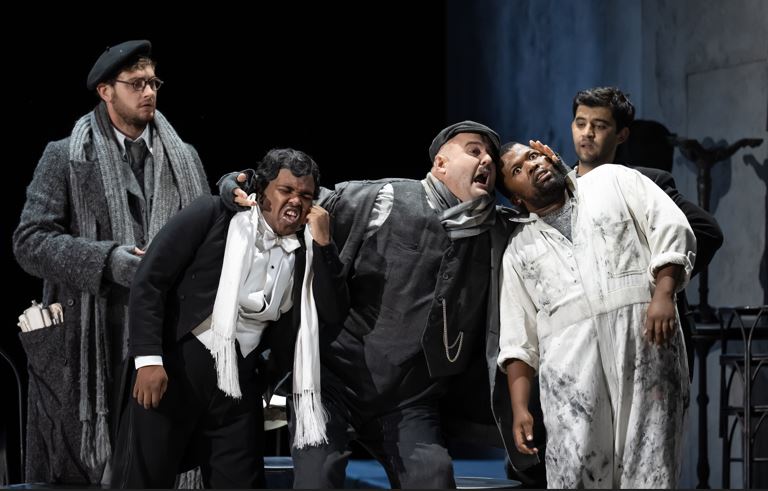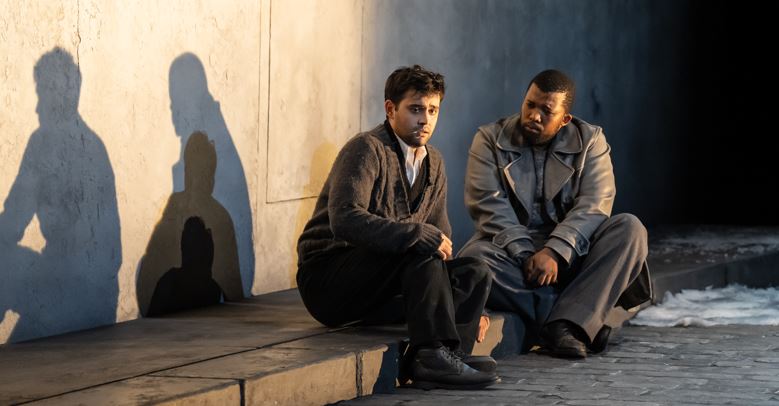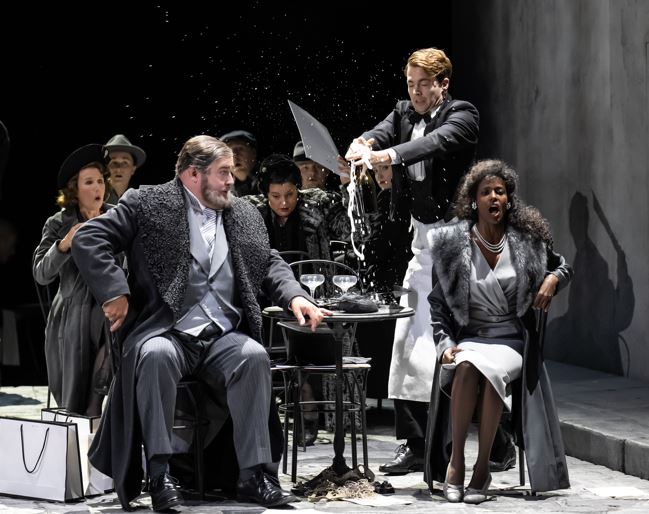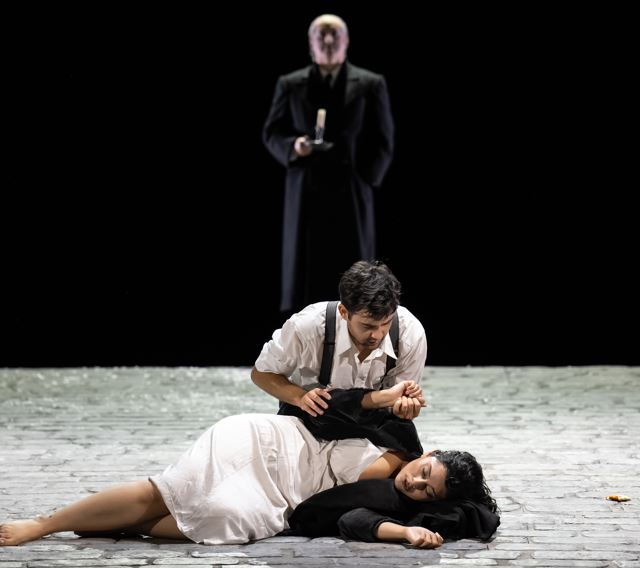La Bohème
Love’s Memento Mori
La Bohème
by Giacomo Puccini, libretto by Luigi Illica and Giuseppe Giacosa
Glyndebourne Productions at Glyndebourne Festival Theatre until 29th October, then on tour until 26th November
Review by Mark Aspen
The street … the street can be a metaphor. It is not home, but it is not strange. It is the way home, but it is a place to meet strangers.
The street forms the sole setting to director Floris Visser’s vision for his semi-figurative production of La Bohème. It is a street that Visser chanced upon strolling off the beaten track one evening in Paris. It seemed to fit the mood of La Bohème, he thought. His set designer Dieuweke Van Reij agreed; thence the genesis of the stark metallic grey setting for Glyndebourne’s 2022 production of Puccini’s most popular opera.
A false perspective gives the impression of a long cobbled street, the sort that always looks damp, receding into the distance. Tall windowless walls frame the sides, and the carriageway seems to disappear over a slight rise in the background. Alex Brok’s inspired lighting design means that characters vanish as they pass over the rise. Much use is made of side batten lighting to accentuate the starkness.
The street is literal in Act Three, which takes place at the Barrière d’Enfer (Gate of Hell) once the tax-collection tollgate to the city of Paris, which had become a very insalubrious quarter by the nineteenth Century. It is where the ill and weakening seamstress Mimi goes searching for her remorseful parted lover Rodolfo, amongst the taverns and houses of ill repute. However, no further set elements are introduced for Acts One and Four in the freezing garret room that the writer Rodolfo shares with his three bohemian friends, neither for the exuberant Café Momus where they spend the closing hours of Christmas Eve in Act Two. So far, so good, in that the audience is invited to share its imagination for the figurative settings framed within the metaphorical street.
La Bohème’s libretto is based on Henri Murger’s Scènes de la vie de bohème, literary snapshots of a story, rather than a continuous plot, mood pieces that set those scenes of the bohemian life. Hence the sequential nature of the opera and the justification of its setting.
“A meeting in an attic between a seamstress and a journalist, they fall in love; they quarrel, then the seamstress dies”. This was the co-librettist of La Bohème, Luigi Illica’s summary of its plot. But it is, of course, much more than that. The opera brilliantly captures the spirit of youth, its spontaneity and its vivacity, but also its anxiety and its tragedy. However, it does embrace with equal intensity the emotions of love and the pathos of death. In Visser’s production, the music and singing captures the former and the direction and presentation the latter.
In Puccini’s score and La Bohème’s libretto there are ironic and prescient memento mori. It starts on Christmas Eve and we know, or fear if new to the story, that Mimi’s life will not last into the spring. It hangs over the beautiful love duets and soaring music, keeping us on tenterhooks. But in this production death is personified as a gaunt silent figure, always and only seen by Mimi, a figure who is omnipresent. The figure is even spelt out as Death in the programme, rather than let the audience use its imagination to interpret the significance. All this seems in contrast to trusting the audience with the imagined set.

The setting is just before the Second World War, with all that is to mean for Paris, adding to the ominous feel of the production. Jon Morell’s costume designs accurately capture the period and its ambience.
Parpignol, the toy-seller outside the Café Momus, doubles as Death and is played by the tenor Peter Van Hulle as lugubrious and inscrutable. He gives bright red balloons to the children, and these stand out against the grey set and costumes like gobs of blood from tubercular lungs. Even without medical knowledge, we know that Mimi has tuberculosis (consumption being romantically literary) but the implication is that even the children will eventually succumb to Death. The only other splash of colour is Mimi’s beret.
This concept is the “U.S.P.” of the Glyndebourne production, but rather lacks subtlety and is overused. Rather than the, admittedly inspired, idea of a personified Death being ubiquitously in the background, it is foregrounded to an extent that it often pulls the focus and detracts from the ambience and beauty of lyrical moments. Regrettably, it intrudes on the intimacy of O soave fanciulla, Mimi and Rodolfo’s famous love duet at the climax of Act One.
Nevertheless, the emotional punch of Puccini’s music cannot be suppressed and in the hands of conductor Rory Macdonald its warmth, its ironies and its pathos are fully realised. He takes the Glyndebourne Tour Orchestra on an immersive and well-paced journey, totally as one with the singers on stage. Puccini is often described as emotionally manipulative, but my, why not when it is as good as Glyndebourne’s exposition in the development of Act One, culminating in Puccini’s triple whammy of the heart-rending Che gelida manina and Sì, mi chiamano Mimì, Rodolfo’s and Mimi’s well-known arias just before their duet.

Penurious poet and sickly seamstress chance to come together in the freezing garret where he has just burnt his precious manuscript in a vain attempt to get warm, because she has no light for her candle. This really is fuel poverty! Tenor Bekhzod Davronov, who hails from Uzbekistan, and Nicaraguan-American soprano Gabriella Reyes, a protégée of the Met, are outstanding as Rodolfo and Mimi. Davronov captures Rodolfo’s youthful enthusiasm and hopefulness with true emotional depth, his singing stylish and effortless right to his higher notes.
Reyes has an enchanting warmth of expression in a lyrical voice that presses all the buttons. From her first Mi chiamano Mimì (I’m called Mimi) with its sweet self-deprecation to her Sono andati? (Have they gone?), Mimi’s final declaration of loving passion, her voice is spine tingling. From her quasi-innocent discovery of love to its desperation at its seeming loss, Reyes acting is immersive, and one can feel her fear as she constantly confronts Death, alone.

Rodolfo’s companions, the bohemian boys of the garret, are a wonderfully animated bunch. They defy the realities of the harshness of their existence with humour and horseplay. There is, though, a coming-of-age as their common support for each other grows, then pairs become mutually supportive, and eventually they realise the fragility of life as best as each can to support Mimi’s dying hours.
Marcello, the painter, is perhaps closest to Rodolfo and it is he who convinces Rodolfo of the strength of Mimi’s love. South African baritone Luthando Qave brings a rich voice and a genuine bonhomie to the role.

As the bookish philosopher, Colline, prize-winning bass William Thomas excels as a studious introvert, examining the world from behind owlish spectacles. His “overcoat aria”, Vecchia zimarra, senti (Listen, dear old coat), in which Colline gives up his ancient overcoat, almost all he has, to sell in order to buy palliative medicine for the dying Mimi, is truly touching.
Luvuyo Mbundu makes a buoyant Schaunard, the musician who just manages to keep his friends afloat with money he occasionally makes busking or teaching. Mbundu, also from South Africa, and with a rich baritone voice, plays Schaunard as braces-twanging, self-assured, almost cocky, and with a barely repressed sense of fun. Interestingly, there is some autobiography in Scaunard, as Puccini himself had a bohemian time as a student at the Conservatorio di Milano, where he shared digs with three fellow students.
The Act Two scene at the Café Momus, when the friends revel on Christmas Eve, not only provides a respite of gaiety in an otherwise grim story, but also provides an opportunity for the chorus to shine. And the Glyndebourne Chorus, supplemented by a children’s chorus drawn from the Glyndebourne Youth Opera and Trinity School, certainly shine as they play the various revellers, street-vendors, waiters plus the soldiers, who form the military band that leads off most of the partygoers. Yet even here, death’s heads are seen on the menu covers and Death himself appears, leading the band.
Café Momus is the place where Musetta, Marcello’s on-off lover, makes her grand entrance. With her sugar daddy, the wealthy and elderly senior politician Alcindoro in tow, and wearing all her seductive finery complete with fur stole, it is an eye-catching entrance … and she knows it. She sings of men longing to see her “hidden charms” in the risqué Musetta’s Waltz, Quando men vo (Whenever I go …), which draws the attention she craves, and soon the whole place is up and dancing, a wonderful ensemble dance piece, skilfully arranged by the Dutch choreographer Pim Veulings.
Mariam Battistelli, an Italian soprano who hails from Ethioia, is superb as Musetta, and brings out her provocative coquettishness. She has fire in her voice and sensuality in her movement. There is feline grace yet feline menace as she walks the assured ankle-crossing steps of the fashion model. It certainly gets the men going. As a waiter serves Musetta with champagne, the cork pops and spurts all over his apron. In a production laden with metaphors the symbolism is not lost, judging from the laughter in the audience. Alcindoro is mortified with embarrassment, while Marcello squirms in distress. However, in truth, Musetta is longing to return to Marcello. She has tired of Alcindoro.
The cunning Musetta gulls Alcindoro into picking up the tab and paying for the full cohort of the bohemian friends. Equally, the four men have already that evening gulled their landlord, the hapless Benoît, into forgoing his due rent, feigning indignation at his supposed adultery with plump paramours. Established bass-baritone Darren Jeffery plays both these older victims: Alcindoro, with irascibility, but increasing resignation, Benoît with gullibility, but decreasing sobriety. The chicanery is all dishonest of course, but illustrative of the frivolity and nimbleness of youth versus the gravity and inertia of age and sets the contrast for the depth of loss when it comes.
Under the guidance of Revival Director Simon Iorio, the contrasts in Puccini’s masterpiece form the vade mecum for this production of La Bohème, in the Glyndebourne Tour’s present version. It is a poignant exposé of the glorious ecstasy of first love set against the agonising loss of early death. But what is ultimately left is irony. In Mimi’s final moments, after intimate recollections with Rodolfo of happy times together, the friends return with a muff, a symbolic parenthesis of Rodolfo’s first act of love, to warm her hands. Rodolfo turns to reflect; in few moments Mimi dies … unnoticed. When Rodolfo returns, he is grief-stricken to find an empty body. For, in the symbol laden production, Mimi’s soul has already walked away … with Death.
Mark Aspen, October 2022
Photography by Bill Cooper ©Glyndebourne Productions Ltd.






Trackbacks & Pingbacks